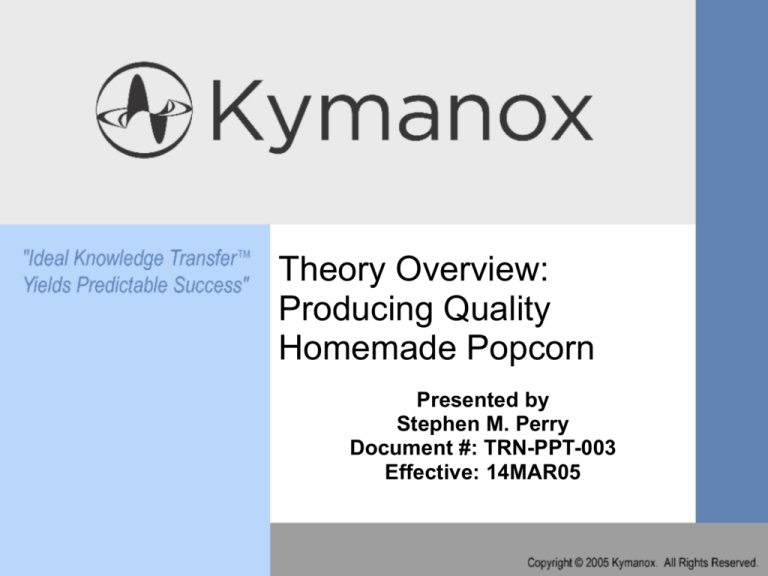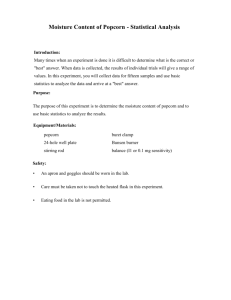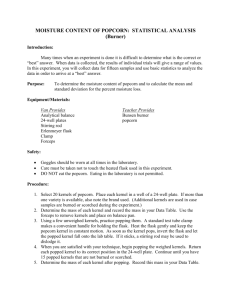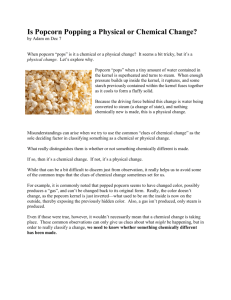Producing Quality Homemade Popcorn
advertisement

Theory Overview: Producing Quality Homemade Popcorn Presented by Stephen M. Perry Document #: TRN-PPT-003 Effective: 14MAR05 Theory Overview Outline Producing Quality Homemade Popcorn • Purpose and Scope • Background and History • Process Theory o o o o Introduction Materials Equipment Techniques • Quiz • References Purpose Why is this necessary? • Conceptually, this overview is a sample component of Ideal Knowledge Transfer™. • Information covered in this presentation addresses some of the reasoning behind the selected methodologies. • By addressing the history and theory involved, key information is better retained and knowledge can develop. Scope What is covered? • This presentation includes pertinent information related to producing quality homemade popcorn: o o o o History Process Theory Materials Techniques • This module provides supplemental information beyond what is included in other materials, such as: o o Standard Operating Procedure (SOP) Demonstration Video • Generally speaking, detailed step-by-step instructions and instructional highlights have been omitted. Background How did this come about? • The “Producing Quality Homemade Popcorn” example was chosen as a simple, fun example to illustrate the possible benefits of Ideal Knowledge Transfer™. • Stephen Perry, the founder of Kymanox, started making homemade popcorn in the mid-1980s and refined the process over the years after much experimentation. History of Popcorn Early • It is believed that the first use of wild and early cultivated corn was popping. 1 • The writings of Peruvian Indians in 1650 say, “They toast a certain kind of corn until it bursts. They call it pisancalla, and they use it as a confection.” 1 • During the Depression, popcorn at 5 or 10 cents a bag was one of the few luxuries down-and-out families could afford. 1 History of Popcorn Recent • Microwave popcorn was the very first use of microwave heating in the 1940s. 1 • Popcorn went into a slump during the early 1950s, when television became popular. Attendance at movie theaters dropped and, with it, popcorn consumption. When the public began eating popcorn at home, the new relationship between television and popcorn led to a resurge in popularity. 1 • Americans today consume 17 billion quarts of popped popcorn each year. 1 Process Theory Introduction + = • Popping corn kernels requires heat to drive a phase change in the small amount of water (i.e., moisture) that normally resides in a kernel. • As the water quickly transforms from a liquid to a gas state, the volume it occupies increases by a factor of 1700 – thus providing the explosive force for popping. • It is important that the heat is transferred quickly, avoiding pervaporation which allows water to escape without creating the explosive force. • The latent moisture in a kernel is therefore critical; kernels should be stored properly to keep their moisture content stable. Process Theory Materials • Popcorn kernels • Heat transfer medium o o o Oil (traditional) Air (hot air popper) Electromagnetic radiation (microwave) • Seasonings o o o Butter Salt Others (not recommended) Materials Popcorn Kernels • Premium kernels are essential for quality popcorn. • The world’s best popcorn is grown in the Midwest: o Illinois, Indiana and Iowa (USA) • Desirable kernel characteristics: o o o o o Relatively large and plump White or yellow in color Ideal moisture content (13-14%) 1 Proper packaging to ensure moisture stability High popped to un-popped volume expansion ratio (>35:1) 1 Materials Heat Transfer Medium • A key factor impacting how a kernel pops is how heat is transferred to the kernel. • Oil is the traditional medium; it has several advantages over air and microwaves: Provides even and continuous contact with the kernel and heating equipment – thus maximizing heat transfer o Adds flavor to the popped corn o Requires no special equipment o • Corn, safflower and canola oils are best and other oils can impart an unwanted taste, e.g., olive, or are not as healthy, e.g., coconut. Materials Seasonings • Although dry popped corn has taste, its taste can be enhanced with simple seasonings: Real butter provides the best taste and does not contain trans-fat that is associated with margarine o A small amount of salt magnifies the corn and butter flavors o • Sugar, caramel, cheese and other flavorings are common but are too dominate and can interfere with the taste of the corn. Process Theory Equipment • Popping equipment desirable characteristics: Ability to transfer heat to heat transfer medium quickly and evenly o Avoid burning o Allow steam to escape o • Holding equipment desirable characteristics: o o o Cool slowly and evenly Allow moisture to escape Allow for transferring, mixing and serving Equipment Table of Options Device Traditional Covered Pot Mechanical Popcorn Popper Hot Air Popper Microwave Picture Advantages Disadvantages Reliable and consistent; not a specialty unit; easy to clean Ensures proper mixing and venting Good technique required Ability to produce low-fat popcorn Loud operation; overly dry popcorn; specialty unit ($ + space) Popping dependant on power rating; must buy prepackaged popcorn Ease-of-use; disposable clean-up Moving parts; hard to clean; specialty unit ($ + space) Equipment Traditional Covered Pot • Although simple, the traditional covered pot may be the best choice for making quality homemade popcorn. • The pot interior should be made of good quality stainless steel (e.g., 18/10) and have a smooth finish on the inside: o o o No pitting or visible corrosion Free of char and scorch stains (impacts heat transfer) Aluminum core and exterior desirable (provides even heating) • The pot height should be close to 4 inches: o o Allows steam to escape Accounts for expected volume expansion if a single layer of kernels is used Equipment Holding Containers • Cooling and mixing container: paper bag o o o o Low heat capacity material (i.e., paper) prevents condensation during cooling Absorbs and wicks moisture – keeping popcorn dry and fluffy Large volume allows for easy bulk cooling and mixing Disposable and recyclable • Serving container: open bowl o o Easy access Decorative • Storage container: covered bowl o o Air-tight for moisture control Preserves freshness Process Theory Techniques • Technique is critical for consistent high quality, high yielding popcorn o o o o o Preheating Popping Cooling Seasoning Serving and storage Techniques Preheating • The water inside the kernel need to reach >100°C so that steam can be created and cause the pressure to build and to provide the explosive “pop.” • The temperature inside the kernel is related to: o o o o Exterior kernel temperature, which is related to Oil temperature, which is related to Pot temperature , which is related to Stove temperature, which is the heat source • The stove, pot and oil should be individually preheated to allow for optimal thermal equilibrium and temperature gradients. • Indicating kernels are used to verify when the oil has reached popping temperature of approximately 210 to 230°C. Techniques Popping Single Layer • For maximum batch yield without compromising other factors, pop as many kernels as it takes to form a single layer in the pot. • Mixing is critical during both heating and popping of the kernels: Keeps kernels evenly coated with hot oil; minimizes temperature variations in the pot o Moves displaced, non-popped kernels to the bottom of the pot so they can return to the oil for popping o • Opening the lid during popping: o o Allows steam to escape Keeps popped kernels dry, light and fluffy • Remove from heat after popping rate declines - not when it has stopped: Popping popcorn kernels absorb heat from the oil, pot and stove – once in decline, the temperature of the pot and oil begins to rise significantly and can cause oil to smoke, imparting a bad taste o Prevents burning and scorching o Techniques Cooling • Cooling is a critical yet often unmanaged step in popcorn production. • Fresh, hot popcorn needs to cool in a controlled fashion: o o Avoids unwanted condensation Paper is ideal surface: Absorbs moisture Wicks moisture Low heat capacity o Glass, porcelain or metal are not recommended: The surface of the popped corn cools too quickly Water condenses on the popped corn Impacted corn becomes dense – an unwanted mouth-feel attribute Corn does not remain fresh as long during storage Techniques Seasoning • Seasoning is a personal preference, but most popcorn enthusiasts celebrate popcorn with simple butter and salt. • The oil used provides flavor – use only sparing amounts of real butter and salt. • Slowly drizzle butter evenly over the popcorn, mixing frequently: o o Do Coat the popcorn evenly and lightly Don’t soak or drench the popcorn • After butter seasoning, carefully add salt to taste: o o Salt will stick to popcorn Dispense slowly over wide area, mixing frequently Techniques Serving and Storage • Dispose the paper bag before serving; although it has great utility, it has unappetizing aesthetics. • Serve the popcorn in a bowl that has easy access for: o o grabbing and eating dispensing to smaller bowls • Popcorn is best consumed immediately after it is prepared. If any popcorn is leftover, store it in an air-tight container at room temperature: o o Be sure popcorn is also at room temperature before sealing container; this will minimize moisture and extend storage time Popcorn should remain fresh for up to 3 days Quiz Select the best answer ??? 1. What is causes a kernel to pop? o o o [A] rapid vaporization of water [B] applied heat at a slow rate [C] chemical reaction with oil 2. What can a paper bag do for popped popcorn? o o o [A] Is an ideal container for initial cooling [B] provides a handy container for mixing/seasoning [C] all of the above 3. If popcorn kernels were baked at 80°C (i.e., 176°F), what would happen? o o o [A] some would pop [B] the kernels would dehydrate and be unsuitable for popping [C] all would pop Quiz, Continued Select the best answer ??? 1. When selecting an oil, what should be considered? o o o [A] taste compatibility with corn [B] smoking point and saturated/trans fat content [C] all of the above 2. Why is preheating oil is necessary? o o o [A] burns off extra oil [B] ensures optimal thermal conditions and rapid heating of kernels [C] minimizes risk of fire 3. What is a drawback of microwave popcorn? o o o [A] independent selection and control of the materials is not possible [B] it is quick, clean and disposable [C] radiation damages the corn flavor Quiz Answers Best Answers Listed 1.A 2.C 3.B 4.C 5.B 6.A References 1. Popcorn Board o o Address: 401 N. Michigan Ave., Chicago, IL 60611 URL: www.popcorn.org 2. Walton Feed, Inc. o o Address: U135 N. 10th, PO Box 307, Montpelier, ID 83254 URL: www.waltonfeed.com Contact Information For more information, contact Kymanox at info@kymanox.com or visit www.kymanox.com






